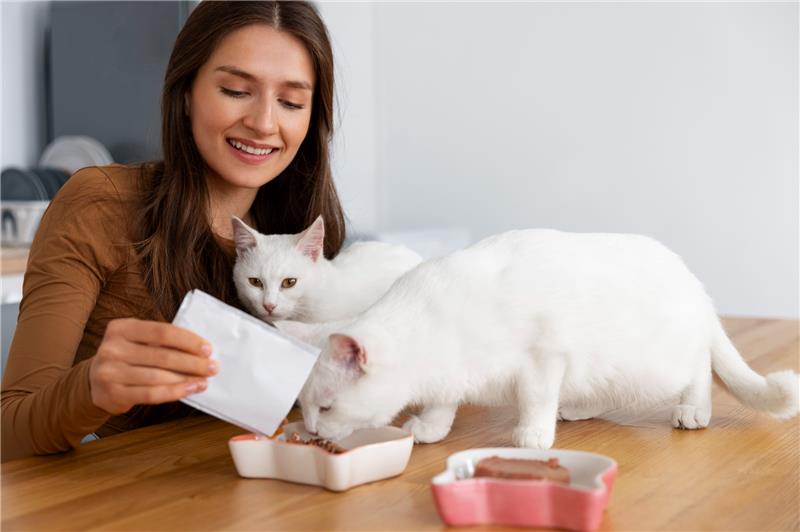How to Help Cats Get Along: Tips and Tricks
Cats, like the elegant Siamese, often project an air of relaxation, appearing aloof and unbothered as they bask in the sun or perch on a windowsill. Yet beneath that calm exterior lies a territorial nature, one that can swiftly erupt when another cat crosses into their domain.
Though the phrase ?catfight? conjures images of playful spats, feline clashes can be anything but lighthearted. Whether introducing a new kitten or navigating disputes between resident cats, bringing peace to a multi-cat household requires patience and a deep understanding of feline behavior.
Types and Causes of Feline Aggression
Before getting into how to help cats get along, let?s have a look at why they het aggressive. There is no specific medical reason why a cat gets aggressive with another cat. However, here are some of the causes that can be a probable reason for their aggressive behavior.
Fear Aggression
This happens when your cat feels threatened or trapped in a situation. When they feel afraid, they act in an aggressive way to defend themselves.
Maternal Aggression
This happens when any person or animal comes close to a mother cat or her kittens. The mother cat might start to hiss or growl, chase, swat, or even try to bite another cat, trying to get close to its babies, even if they get along most of the time. This goes away after the kittens are weaned.
Play Aggression
When cats play, it mainly consists of mock aggression. So, do not get scared when they are playing rough. Cats may pounce, stalk, kick, swipe, sneak, and ambush each other while they are playing. However, this can lead to overstimulation, and then lead to aggression. This basically happens with cats who have a significant age difference.
Territorial Aggression
Animals are known to be territorial. When they think someone is getting into their territory, they can try to chase the intruder, growl, or swat, no matter if it is another person or a kitten the family just got.
How to Help Cats Get Along?
Getting along with the new family and other pet friends, be it another cat or a dog, is an important milestone for a cat. So, how to help cats get along? Well, here are a few tips to manage and prepare them for the process.
1. Gradual Introductions for New Cats
Rushing introductions can trigger anxiety or aggression. Start slowly, allowing the new cat and the resident cat to grow familiar with one another without immediate, direct contact.
Separate Spaces
Give each cat its own area in the house. The new cat should have a safe zone where it can explore, free from threats, while the resident cat continues to enjoy its familiar territory. This separation gives both cats time to adjust to the idea of coexisting.
Scent Swapping
Cats depend on scent to recognize and accept other animals. Start by exchanging their bedding or toys, letting each cat absorb the other?s scent from a distance. This tactic helps build familiarity before they even meet face-to-face.
Slow, Supervised Meetings
Once both cats seem comfortable with the scent exchange, allow them to observe one another through a baby gate or a cracked door. These controlled interactions help ease the tension while preventing direct confrontation. If neither cat displays hostility, slowly progress to supervised meetings where they can interact in a calm, controlled setting.
2. Positive Associations
Creating positive associations between cats helps prevent animosity. Cats, like many creatures, can link experiences to emotions. By associating the presence of another cat with enjoyable activities, you can help foster peaceful coexistence.
Treats and Playtime
Offer treats or engage both cats in play while they?re near one another. This creates a connection between the other cat?s presence and something rewarding. Gradually reduce the space between them as they grow more accustomed to being in the same room.
Feeding Together
Food acts as a powerful tool for forging bonds. Feed the cats in the same room but keep their bowls at a safe distance. Gradually bring the bowls closer over time. Sharing meals teaches the cats to associate each other?s proximity with something they enjoy, fostering a positive bond.
3. Creating Safe Spaces
Cats need places where they feel secure. These sanctuaries allow them to decompress, preventing stress and territorial aggression.
Vertical Territory
Provide cat trees, shelves, or other vertical spaces. These perches let cats retreat and survey their surroundings from above, giving them a sense of control. Height often calms tensions, as it allows each cat to observe without feeling threatened.
Personal Hiding Spots
In addition to high vantage points, each cat should have its own private retreat?whether a cozy bed or a tucked-away corner. Offering these hideaways ensures that every cat has a place to relax when feeling overwhelmed, reducing the likelihood of conflicts.
4. Managing Tension Between Existing Cats
Even established households can experience conflict. Recognizing and managing the causes of tension can prevent minor disputes from escalating into bigger issues.
Identifying Triggers
Pinpoint what sparks the tension?whether it?s competition over food, space, or toys. Pay attention to when and where the conflict arises. Addressing these triggers directly can help ease the tension.
Reintroductions
If the conflict continues, consider temporarily separating the cats before gradually reintroducing them using the same techniques for introducing new cats. This break allows them to reset and approach each other with fresh perspectives.
Distraction and Redirection
When tension builds, interrupt the situation by engaging the cats with toys or treats. Redirecting their focus can break the cycle of aggression, giving them an outlet for their energy and preventing the conflict from escalating further.
5. When to Seek Help
If tensions persist or escalate despite your best efforts, it may be time to consult a veterinarian or feline behaviorist. Health issues or underlying behavioral problems could be fueling the aggression. A professional can help identify the root causes and offer tailored solutions for your cats.
Conclusion
Thinking of how to help cats get along? Well, the above-mentioned tips can help with that. Gradual introductions, positive experiences, and creating spaces where each cat feels secure all contribute to a harmonious home. With persistence and understanding, most cats can learn to coexist, bringing calm to your household.
Give your cats the patience they deserve and allow them the time they need to adjust. While some cats might quickly accept a new companion, others may need more time to feel comfortable.
By respecting their individual needs and handling conflicts with care, you can create lasting harmony between your feline companions.
More Resources:






















